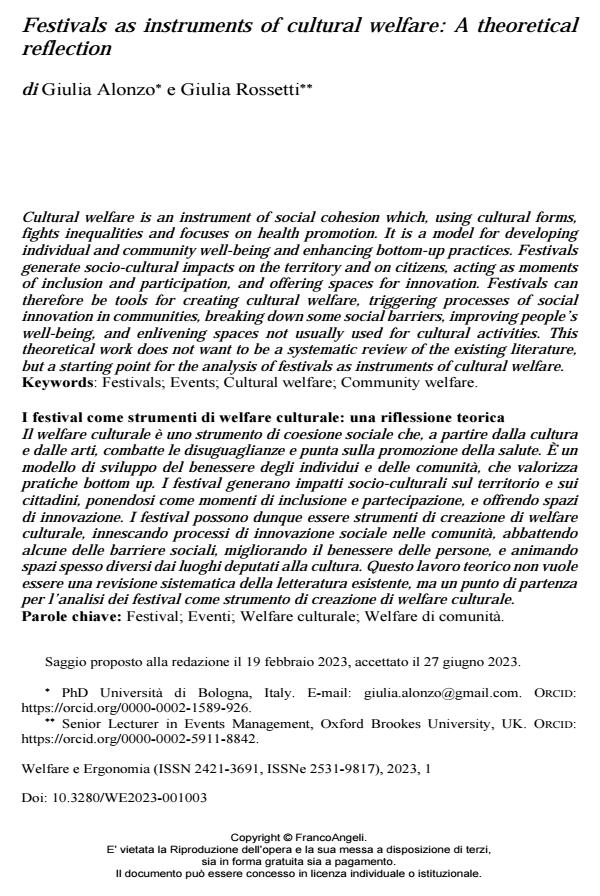Festivals as instruments of cultural welfare: A theoretical reflection
Titolo Rivista WELFARE E ERGONOMIA
Autori/Curatori Giulia Alonzo, Giulia Rossetti
Anno di pubblicazione 2023 Fascicolo 2023/1
Lingua Inglese Numero pagine 14 P. 25-38 Dimensione file 370 KB
DOI 10.3280/WE2023-001003
Il DOI è il codice a barre della proprietà intellettuale: per saperne di più
clicca qui
Qui sotto puoi vedere in anteprima la prima pagina di questo articolo.
Se questo articolo ti interessa, lo puoi acquistare (e scaricare in formato pdf) seguendo le facili indicazioni per acquistare il download credit. Acquista Download Credits per scaricare questo Articolo in formato PDF

FrancoAngeli è membro della Publishers International Linking Association, Inc (PILA)associazione indipendente e non profit per facilitare (attraverso i servizi tecnologici implementati da CrossRef.org) l’accesso degli studiosi ai contenuti digitali nelle pubblicazioni professionali e scientifiche
Cultural welfare is an instrument of social cohesion which, using cultural forms, fights inequalities and focuses on health promotion. It is a model for developing individual and community well-being and enhancing bottom-up practices. Festivals generate socio-cultural impacts on the territory and on citizens, acting as moments of inclusion and participation, and offering spaces for innovation. Festivals can therefore be tools for creating cultural welfare, triggering processes of social innovation in communities, breaking down some social barriers, improving people’s well-being, and enlivening spaces not usually used for cultural activities. This theoretical work does not want to be a systematic review of the existing literature, but a starting point for the analysis of festivals as instruments of cultural welfare.
Il welfare culturale è uno strumento di coesione sociale che, a partire dalla cultu-ra e dalle arti, combatte le disuguaglianze e punta sulla promozione della salute. È un modello di sviluppo del benessere degli individui e delle comunità, che valo-rizza pratiche bottom up. I festival generano impatti socio-culturali sul territorio e sui cittadini, ponendosi come momenti di inclusione e partecipazione, e offren-do spazi di innovazione. I festival possono dunque essere strumenti di creazione di welfare culturale, innescando processi di innovazione sociale nelle comunità, abbattendo alcune delle barriere sociali, migliorando il benessere delle persone, e animando spazi spesso diversi dai luoghi deputati alla cultura. Questo lavoro teorico non vuole essere una revisione sistematica della letteratura esistente, ma un punto di partenza per l’analisi dei festival come strumento di creazione di wel-fare culturale.
Parole chiave:Festival; Eventi; Welfare culturale; Welfare di comunità.
- Cultural gene characterization and mapping of traditional tibetan village landscapes in Western Sichuan, China Ding Fan, Nor Zarifah Binti Maliki, Chuan He, Yu Bi, Siwei Yu, in npj Heritage Science 317/2025
DOI: 10.1038/s40494-025-01877-7
Giulia Alonzo, Giulia Rossetti, Festivals as instruments of cultural welfare: A theoretical reflection in "WELFARE E ERGONOMIA" 1/2023, pp 25-38, DOI: 10.3280/WE2023-001003